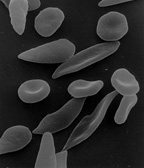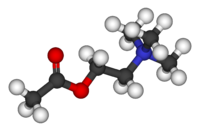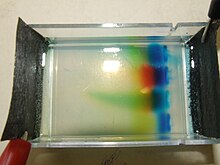Structural Biochemistry/Outside the Cell
The discoveries that come out of biochemistry research not only leads to a better understanding of cells but also impacts other areas.
Medicine
[edit | edit source]Our bodies are a home to millions of chemical reactions which allow us to be function smoothly and efficiently. From building more tissue to metabolizing food, our bodies are constantly taking reactants and creating products. Many diseases can be traced to problems in protein function. Some are genetic, others simply develop over time.

Sickle Cell Anemia
[edit | edit source]Sickle cell anemia is a genetic disease that is caused by a mutation of one amino acid; in the beta chain the glutamate in position 6 is replaced by a valine. This leads to the hemoglobin binding in a strand formation that has the shape of a "C" instead of a disk shaped. This decreases their efficiency to transport oxygen in the body. They do not move as well in the blood vessels and tend to form clumps. Sickle cells also tend to die at a more rapid rate that regular blood cells but the bone marrow is not able to compensate quickly enough for the loss.
Sickle cell is a recessive gene meaning that the gene must be inherited from both parents. But even when a person simply has the trait, they only inherited it from one parent, their blood flow is affected but they do not have the disease.[1]
Cystic Fibrosis
[edit | edit source]Cystic fibrosis is another another recessive genetic disease caused by a lack of a protein. The disease is characterized by excessive excess mucus production, coughing, and frequent chest infections.[2] It is caused by the lack of a CFTR, cystic fibrosis transmembrane conductance regulator, protein. It is an ion channel that is usually found across a cell membranes that produce saliva, mucus, sweat and digestive enzymes. A cellular signal tells the channel to transport chlorine which regulates the movement of water in tissues or osmosis. This maintains the fluidity of secretions such as mucus.[3]
Pharmacology
[edit | edit source]Pharmacology is the study of the activity of drugs in the body. Pharmacologists look at how different medicines or molecules interact with cells and how the interaction can be manipulated for a desired effect. The interactions between drugs and the body are simply chemical reactions and understanding them leads to creating better drugs. Most often medicines are created to interact with enzymes and one of the challenges of pharmacology is how to make a molecule specific enough to only interact with the needed protein.
How a molecule interactions with a receptor can characterize it as a agonist or antagonist. When an agonist reaches a receptor it tells the cell to do something creating a cellular reaction. An antagonist does exactly the opposite; it keeps an action from happening. Drugs can act as either. Many drugs are used to control overactive responses such as high blood pressure or an increasing heart rate.
Importance of Structure
[edit | edit source]In order for a drug to work it must have the correct structure. Molecules that have very general structures create a wide variety of cellular responses often seen as side effects. These drugs fit in to many receptors and therefore have many responses. This also reduces the desired effect of the drug. Therefore structural biochemistry is crucial for improving drugs. The more we know about a certain protein and its structure, the more specific we can make a drug that will hopefully only interact with that specific protein.

Examples
[edit | edit source]Curare
[edit | edit source]Curare is an antagonistic drug that creates muscle paralysis. It is extracted from plants and has been used by South American indigenous people to poison arrows when hunting animals. Curare paralysis muscles by blocking chemical signals between nerve cells and muscle cells. In a normal situation nerve cells put out acetylcholine which is detected by receptors on muscle cells, telling them to contract. Curare has a very similar chemical structure to acetylcholine and is able to place itself in the muscle receptor keeping acetylcholine from entering the receptor and therefore paralyzing the muscle. [4] [5]
MDR Pumps
[edit | edit source]MDR pumps are proteins that are positioned in the membrane of some cells. They are often seen as a defense system used by bacteria. MDR pumps monitor the chemicals that are coming in to the cell and discard any that may endanger the bacteria. This is a problem for antibiotics that are not able to kill these bacterium. But this pump is not found on most plant cells. Plants have many chemical defenses against bacteria and one is the ability to keep bacteria from implanting the MDR pump in them. Scientists are trying to see if using a chemical from plants with antibiotics will create a stronger medicine against bacteria.
But MDR pumps are also seen in normal cells and can keep drugs from doing what they need to do. But they also perform important functions like regulating hormones.

MDR Pumps & Cancer
[edit | edit source]MDR pumps are especially tricky when dealing with cancer treatment. In cancer cells, MDR pumps eject chemotherapy treatment molecules, making the toxic therapy much less efficient than desired. The more MDR pumps the cancer cells have, the less effective chemotherapy will be. Chemotherapy is still hard on the patient's own cells, though, especially cells in the body that have few or no MDR pumps: stem cells in bone marrow. Bone marrow toxicity is a major downside/risk with chemotherapy because without MDR ejection systems, bone marrow stem cells are very susceptible to being harmed by the chemotherapy. One possible way of attempting to lessen this effect on stem cells is through gene therapy. The intended outcome of gene therapy in this case would be to introduce the gene that encodes MDR pump formation into the DNA of stem cells in the bone marrow. If incorporated into stem cell DNA, it would allow stem cells in the bone marrow to arm themselves with MDR pumps, and hopefully be better defended against chemotherapy. The gene therapy process is as follows:
1: Stem cells removed from the patient (these cells do not contain MDR pumps)
2: a piece of RNA with the genetic code corresponding to MDR is placed in a retrovirus
3: the retrovirus is introduced into the patient's procured stem cell sample
4: the retrovirus' RNA is incorporated into the cell
5: with reverse transcriptase, the viral genetic code (which includes the MDR insert) is incorporated into the DNA of the stem cell
6: this cell reproduces, and the code for MDR is passed on to each new stem cell
7: the genetically enhanced stem cells that now contain MDR pumps are re-introduced into the patient's bone marrow, and the number of cells containing MDR will increase as stem cells reproduce, overall increasing the patient's bone marrow's defenses against chemotherapy [6]
Bacteria with Dangerously-Efficient MDR Pumps
[edit | edit source]MDR pumps in gram-negative bacteria (which include E. coli), specifically S. aureus, is very adept at protecting itself from antibacterial soaps and lotions. This can lead to its increased resistance to antibiotics, of course the inefficiency of the antibiotic, and ultimately possible serious infections.
Another notable bacteria that has dangerously-efficient MDR pumps is P. aeruginosa. This bacteria causes a life-threatening infection called sepsis, and it is so dangerous because it ejects nearly every single substance that attempts cross its membrane. [7]
Drug Development
[edit | edit source]Many of the basic biochemical concepts underlying pharmacology also apply for drug development. In the past drug development was called preclinical development for it encompasses everything that happens to a drug before being put in use; discovery, development, and animal testing. In the past most drugs have been discovered by analyzing old remedies and finding the specific chemical that induces the desired effect. Today, drug developers try to understand the target entity at a molecular and physiological level and target specific properties.[8]
The Research & Discovery Process
[edit | edit source]The development of pharmaceuticals is a process with many stages and overall takes at least 12–15 years, usually longer. During the discovery stages of drug research, thousands of compounds may be investigated. This is a labor intensive process that involves individual and team research and planning. Most compounds developed do not become clinically tested drugs. There are many things that could lead to the failure of a particular compound:
It is not just in the research stage that a potential drug can be rejected. Sometimes even after years of development and progression, a drug can fail in clinical trials or another complication could arise even after much time and money had been invested.
During a new drug's early preclinical development, the sponsor's primary goal is to determine if the product is reasonably safe for initial use in humans, and if the compound exhibits pharmacological activity that justifies commercial development. When a product is identified as a viable candidate for further development, the sponsor then focuses on collecting the data and information necessary to establish that the product will not expose humans to unreasonable risks when used in limited, early-stage clinical studies. At that point, the molecule changes in legal status under the Federal Food, Drug, and Cosmetic Act and becomes a new drug subject to specific requirements of the drug regulatory system. An Investigator IND (investigational new drug) application is submitted by a physician who both initiates and conducts an investigation, and under whose immediate direction the investigational drug is administered or dispensed.
For decades, the regulation and control of new drugs in the United States has been based on the New Drug Application (NDA). Since 1938, every new drug has been the subject of an approved NDA before U.S. commercialization. The NDA application is the vehicle through which drug sponsors formally propose that the FDA approve a new pharmaceutical for sale and marketing in the U.S. The data gathered during the animal studies and human clinical trials of an Investigational New Drug (IND) become part of the NDA. The documentation required in an NDA is supposed to tell the drug's whole story, including what happened during the clinical tests, what the ingredients of the drug are, the results of the animal studies, how the drug behaves in the body, and how it is manufactured, processed and packaged. [9]
The success of a compound as a final pharmaceutical product is a multidisciplinary effort between many scientists of many different disciplines.
Examples
[edit | edit source]Taxol
[edit | edit source]
Taxol is a common chemotherapy drug often used for leukemia, and breast, ovarian, brain, and lung tumors. It has very unique biological interactions. It works by inhibiting mitosis by binding to tubulin. It attaches to assembled microtubules and prevents it from disassembling and stopping the cells from regenerating. Other drugs usually kept the tubulin from creating microtubules and while the overall end process is the same, stopping cell division, scientists felt that this may work better in some situations. In 1971 the molecule was extracted from a pacific yew tree's bark. The initial testing of the compound made it a very potent cancer drug. But the bark from one tree produced only enough for one dose of the medicine and the drug was in very short supply. As a solution a relative of the pacific yew, the common yew was found to contain a compound very similar to taxol. With a little bit of chemical manipulation the compound can be converted in to taxol.[10]
Viagra
[edit | edit source]Initially Viagra, or Sildenafil, was looked in to as a high-blood pressure or heart disease medication. But the medication proved not be effective on either of these conditions and had a side effect of inducing penile erections. The medication works by releasing nitric oxide which binds to the guanylate cyclase enzyme, which regulates blood flow to the penis. This leads to increased cGMP levels which leads to increased blood flow.
-
catalytic domain of human soluble guanylate cyclase 1
Forensic Science
[edit | edit source]
Forensic science, often called forensics, is the use of many sciences to assist the legal system. This can range from analyzing skeletal remains to analyzing a piece of DNA, placing some one at the scene of the crime.[11]
Forensic scientists often use a technique called DNA profiling to identify persons of interest. The scientists create a DNA profile for the person which uses an encrypted number system to express the DNA make-up of the person and can be used to identify a person. About 99.9% of the human genome is shared by every human. Therefore a DNA profile does not sequence an entire genome but only sequences the part that is unique to an individual.
The process begins by finding a source for the desired DNA. The preferred method is through a buccal swab which decreases the chance of contamination but other methods include saliva, hair, or sperm samples from toothbrushes, razors, or samples. The sample can then analyzed through a variety of different techniques such as PCR which amplifies a specific portion of DNA, single molecule DNA sequencing which sequences a DNA strand, or gel electrophoresis. The sample is then compared against an unknown sample for a match. [12]
References
[edit | edit source]- ↑ http://www.nhlbi.nih.gov/health/dci/Diseases/Sca/SCA_WhatIs.html
- ↑ http://en.wikipedia.org/wiki/Cystic_fibrosis
- ↑ http://en.wikipedia.org/wiki/CFTR_(gene)
- ↑ http://en.wikipedia.org/wiki/Curare
- ↑ Medicines by Design
- ↑ http://web.archive.org/20100604022446/scicom.ucsc.edu/scinotes/9701/full/features/urechis/MDR_Function.html
- ↑ http://web.archive.org/20020621032336/scicom.ucsc.edu/scinotes/9701/full/features/urechis/Bacteria.html
- ↑ http://en.wikipedia.org/wiki/Drug_discovery
- ↑ http://www.fda.gov/Drugs/DevelopmentApprovalProcess/HowDrugsareDevelopedandApproved/ApprovalApplications/NewDrugApplicationNDA/default.htm
- ↑ http://www.phcog.org/Taxus/Taxus_Web.html
- ↑ http://en.wikipedia.org/wiki/Forensic_science
- ↑ http://en.wikipedia.org/wiki/Genetic_fingerprinting





